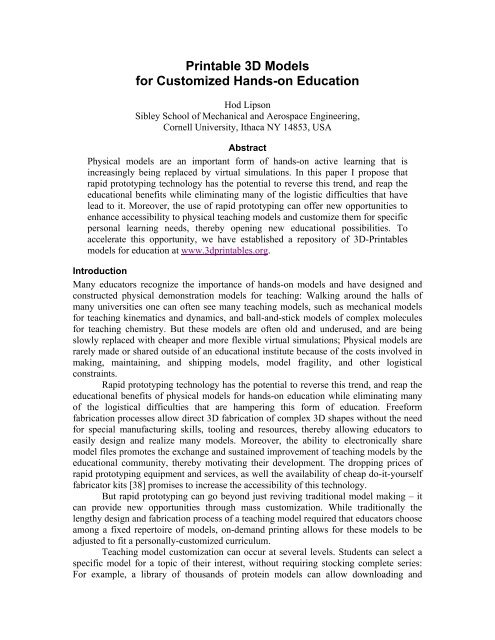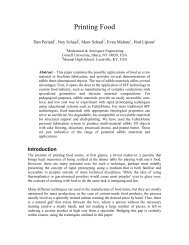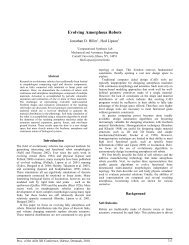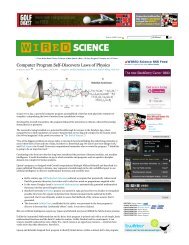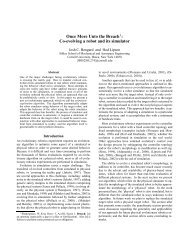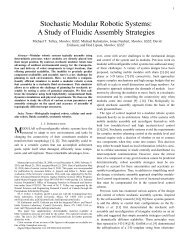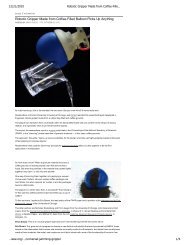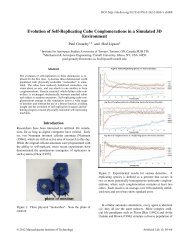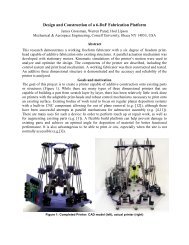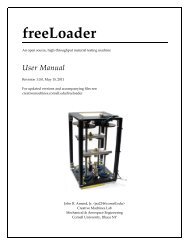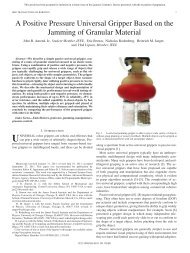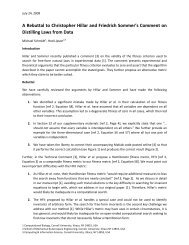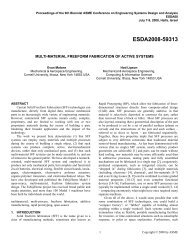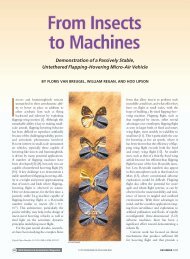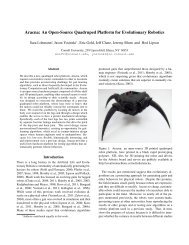Printable 3D Models for Customized Hands-on Education - Cornell ...
Printable 3D Models for Customized Hands-on Education - Cornell ...
Printable 3D Models for Customized Hands-on Education - Cornell ...
You also want an ePaper? Increase the reach of your titles
YUMPU automatically turns print PDFs into web optimized ePapers that Google loves.
<str<strong>on</strong>g>Printable</str<strong>on</strong>g> <str<strong>on</strong>g>3D</str<strong>on</strong>g> <str<strong>on</strong>g>Models</str<strong>on</strong>g><br />
<str<strong>on</strong>g>for</str<strong>on</strong>g> <str<strong>on</strong>g>Customized</str<strong>on</strong>g> <str<strong>on</strong>g>Hands</str<strong>on</strong>g>-<strong>on</strong> Educati<strong>on</strong><br />
Hod Lips<strong>on</strong><br />
Sibley School of Mechanical and Aerospace Engineering,<br />
<strong>Cornell</strong> University, Ithaca NY 14853, USA<br />
Abstract<br />
Physical models are an important <str<strong>on</strong>g>for</str<strong>on</strong>g>m of hands-<strong>on</strong> active learning that is<br />
increasingly being replaced by virtual simulati<strong>on</strong>s. In this paper I propose that<br />
rapid prototyping technology has the potential to reverse this trend, and reap the<br />
educati<strong>on</strong>al benefits while eliminating many of the logistic difficulties that have<br />
lead to it. Moreover, the use of rapid prototyping can offer new opportunities to<br />
enhance accessibility to physical teaching models and customize them <str<strong>on</strong>g>for</str<strong>on</strong>g> specific<br />
pers<strong>on</strong>al learning needs, thereby opening new educati<strong>on</strong>al possibilities. To<br />
accelerate this opportunity, we have established a repository of <str<strong>on</strong>g>3D</str<strong>on</strong>g>-<str<strong>on</strong>g>Printable</str<strong>on</strong>g>s<br />
models <str<strong>on</strong>g>for</str<strong>on</strong>g> educati<strong>on</strong> at www.3dprintables.org.<br />
Introducti<strong>on</strong><br />
Many educators recognize the importance of hands-<strong>on</strong> models and have designed and<br />
c<strong>on</strong>structed physical dem<strong>on</strong>strati<strong>on</strong> models <str<strong>on</strong>g>for</str<strong>on</strong>g> teaching: Walking around the halls of<br />
many universities <strong>on</strong>e can often see many teaching models, such as mechanical models<br />
<str<strong>on</strong>g>for</str<strong>on</strong>g> teaching kinematics and dynamics, and ball-and-stick models of complex molecules<br />
<str<strong>on</strong>g>for</str<strong>on</strong>g> teaching chemistry. But these models are often old and underused, and are being<br />
slowly replaced with cheaper and more flexible virtual simulati<strong>on</strong>s; Physical models are<br />
rarely made or shared outside of an educati<strong>on</strong>al institute because of the costs involved in<br />
making, maintaining, and shipping models, model fragility, and other logistical<br />
c<strong>on</strong>straints.<br />
Rapid prototyping technology has the potential to reverse this trend, and reap the<br />
educati<strong>on</strong>al benefits of physical models <str<strong>on</strong>g>for</str<strong>on</strong>g> hands-<strong>on</strong> educati<strong>on</strong> while eliminating many<br />
of the logistical difficulties that are hampering this <str<strong>on</strong>g>for</str<strong>on</strong>g>m of educati<strong>on</strong>. Free<str<strong>on</strong>g>for</str<strong>on</strong>g>m<br />
fabricati<strong>on</strong> processes allow direct <str<strong>on</strong>g>3D</str<strong>on</strong>g> fabricati<strong>on</strong> of complex <str<strong>on</strong>g>3D</str<strong>on</strong>g> shapes without the need<br />
<str<strong>on</strong>g>for</str<strong>on</strong>g> special manufacturing skills, tooling and resources, thereby allowing educators to<br />
easily design and realize many models. Moreover, the ability to electr<strong>on</strong>ically share<br />
model files promotes the exchange and sustained improvement of teaching models by the<br />
educati<strong>on</strong>al community, thereby motivating their development. The dropping prices of<br />
rapid prototyping equipment and services, as well the availability of cheap do-it-yourself<br />
fabricator kits [38] promises to increase the accessibility of this technology.<br />
But rapid prototyping can go bey<strong>on</strong>d just reviving traditi<strong>on</strong>al model making – it<br />
can provide new opportunities through mass customizati<strong>on</strong>. While traditi<strong>on</strong>ally the<br />
lengthy design and fabricati<strong>on</strong> process of a teaching model required that educators choose<br />
am<strong>on</strong>g a fixed repertoire of models, <strong>on</strong>-demand printing allows <str<strong>on</strong>g>for</str<strong>on</strong>g> these models to be<br />
adjusted to fit a pers<strong>on</strong>ally-customized curriculum.<br />
Teaching model customizati<strong>on</strong> can occur at several levels. Students can select a<br />
specific model <str<strong>on</strong>g>for</str<strong>on</strong>g> a topic of their interest, without requiring stocking complete series:<br />
For example, a library of thousands of protein models can allow downloading and
printing any single molecule model <strong>on</strong> demand. <str<strong>on</strong>g>Models</str<strong>on</strong>g> can be fabricated at various<br />
scales to suit their target use (e.g. pers<strong>on</strong>al use or large-class dem<strong>on</strong>strati<strong>on</strong>s), and to<br />
meet allocated budget. With more adjustment, models can be fabricated with different<br />
densities, materials, colors, surface properties and internal structure to dem<strong>on</strong>strate<br />
various properties such as fricti<strong>on</strong> and inertia. Ultimately, models can be modified in<br />
more intricate ways to dem<strong>on</strong>strate more subtle issues, and models can be modified by<br />
students themselves to answer questi<strong>on</strong>s and to explore new directi<strong>on</strong>s – that may have<br />
been un<str<strong>on</strong>g>for</str<strong>on</strong>g>eseen by the original model designer.<br />
Motivati<strong>on</strong> <str<strong>on</strong>g>for</str<strong>on</strong>g> physical models in educati<strong>on</strong><br />
Physical models are important <str<strong>on</strong>g>for</str<strong>on</strong>g> active learning<br />
There is ample evidence that learning is enhanced through active experiences [1,17]. This<br />
is especially true when spatial and physical c<strong>on</strong>cepts are involved that are difficult to<br />
visualize and understand abstractly [3], even with the help of simulati<strong>on</strong>s and virtual<br />
models. A study of knowledge retenti<strong>on</strong> showed that <strong>on</strong>ly about 20% of knowledge is<br />
retained when <strong>on</strong>ly abstract c<strong>on</strong>ceptualizati<strong>on</strong> is involved, but as much as 90% of is<br />
retained when the c<strong>on</strong>crete experience is involved [30]. Learning theories and practical<br />
studies also suggest that a significant porti<strong>on</strong> of undergraduate engineering students are<br />
sensory types that require hands-<strong>on</strong> experience to be engaged. St<strong>on</strong>e ad McAdams [31]<br />
report overwhelming success in teaching using c<strong>on</strong>crete physical manipulati<strong>on</strong>, and<br />
describe it as a ‘counter culture’ to the trend of increasingly virtual-analysis based<br />
educati<strong>on</strong>.<br />
Physical models may alleviate some learning disabilities<br />
Students with some types of disabilities would benefit from physical teaching models<br />
even more directly. Approximately 24,000 children and students in the U.S. suffer from<br />
severe visual impairment [33], allowing them to acquire spatial c<strong>on</strong>cepts <strong>on</strong>ly through<br />
verbal descripti<strong>on</strong> or direct hands-<strong>on</strong> manipulati<strong>on</strong>. Less severe but more pervasive and<br />
more difficult to diagnose are students with visual spatial percepti<strong>on</strong> learning disabilities<br />
[32]; these students have difficulty perceiving spatial c<strong>on</strong>cepts from 2D pictures or<br />
descripti<strong>on</strong>s, and benefit directly from hands-<strong>on</strong> manipulati<strong>on</strong>.<br />
Physical models may help alleviate gender disadvantages due to differences in<br />
spatial reas<strong>on</strong>ing and cogniti<strong>on</strong><br />
The importance of hands-<strong>on</strong> manipulatives <str<strong>on</strong>g>for</str<strong>on</strong>g> teaching engineering may also help in<br />
alleviating gender-based disadvantages in spatial percepti<strong>on</strong>. Men often outper<str<strong>on</strong>g>for</str<strong>on</strong>g>m<br />
women in tasks that require spatial ability [1,22,27,18,35,24,6,14,10], the use of which is<br />
paramount to success in engineering and the sciences. For example, mental rotati<strong>on</strong> is the<br />
ability to imagine the trans<str<strong>on</strong>g>for</str<strong>on</strong>g>mati<strong>on</strong> of a <str<strong>on</strong>g>3D</str<strong>on</strong>g> object, and this ability has shown a<br />
c<strong>on</strong>sistent pattern of gender differences [11,34]. Men rotate objects faster [9,21] and<br />
more accurately [13,16,18,24,35] than women. Several factors may c<strong>on</strong>tribute to these<br />
gender differences, including gender-based socializati<strong>on</strong>, practice, experience, and beliefs<br />
about their own capabilities.<br />
The factors that that govern spatial percepti<strong>on</strong> abilities are subjects of numerous<br />
studies [6] but individual’s prior experience with spatial tasks is key [4], and the<br />
experiences that provide such practice are more comm<strong>on</strong> <str<strong>on</strong>g>for</str<strong>on</strong>g> boys [29]. Male children are<br />
encouraged to play with c<strong>on</strong>structi<strong>on</strong> toys that require spatial manipulati<strong>on</strong> more than
female children [2,5,6,14,18]. In a vicious circle, lack of practice tends to reduce<br />
motivati<strong>on</strong> and increase the likelihood of failure and discouragement, thereby further<br />
lessening the chances of engaging in spatially oriented tasks [29]. If gender differences in<br />
spatial abilities are c<strong>on</strong>nected to parental encouragement in gender-stereotyped activities,<br />
then practice or training in spatial activities might eliminate, or at least alleviate, these<br />
differences. Indeed, with some types of training women may increase their per<str<strong>on</strong>g>for</str<strong>on</strong>g>mance<br />
to the level of men [10].<br />
Spatial percepti<strong>on</strong> is important in all engineering and science fields, but is<br />
particularly critical in fields like mechanical engineering, civil engineering, and<br />
architecture, which involve extensive use of <str<strong>on</strong>g>3D</str<strong>on</strong>g> geometry. Other fields, like biology,<br />
chemistry, material science and nanotechnology also increasingly require understanding<br />
of spatial c<strong>on</strong>cepts at the nano and micro scale.<br />
Creating an <strong>on</strong>line library of printable teaching models<br />
Our goal is to provide renewed opportunities <str<strong>on</strong>g>for</str<strong>on</strong>g> educators to use and share physical<br />
teaching models across all disciplines. The website www.3dprintables.org. is a wiki-style<br />
public library of printable educati<strong>on</strong>al models that will allow educati<strong>on</strong>al institutes<br />
equipped with rapid prototyping equipment to share and fabricate accurate, full-size,<br />
functi<strong>on</strong>al models <str<strong>on</strong>g>for</str<strong>on</strong>g> educati<strong>on</strong>. Some example functi<strong>on</strong>al models [12] are shown in<br />
Figure 1.<br />
Figure 1. <str<strong>on</strong>g>Printable</str<strong>on</strong>g> models <str<strong>on</strong>g>for</str<strong>on</strong>g> teaching kinematics [26], STL files available <str<strong>on</strong>g>for</str<strong>on</strong>g> download<br />
<str<strong>on</strong>g>Models</str<strong>on</strong>g> in the library can span across many disciplines, with a wide range of<br />
physical scales and mathematical abstracti<strong>on</strong>:<br />
<str<strong>on</strong>g>Models</str<strong>on</strong>g> <str<strong>on</strong>g>for</str<strong>on</strong>g> Biomechanics: e.g. Finger and knee joints, tend<strong>on</strong> extensor<br />
mechanisms<br />
<str<strong>on</strong>g>Models</str<strong>on</strong>g> <str<strong>on</strong>g>for</str<strong>on</strong>g> Biology: e.g. folded proteins, dem<strong>on</strong>strating docking geometries<br />
<str<strong>on</strong>g>Models</str<strong>on</strong>g> <str<strong>on</strong>g>for</str<strong>on</strong>g> Aer<strong>on</strong>autics: e.g. wing shapes, wind-tunnel models
<str<strong>on</strong>g>Models</str<strong>on</strong>g> <str<strong>on</strong>g>for</str<strong>on</strong>g> Math: e.g. <str<strong>on</strong>g>3D</str<strong>on</strong>g> fractals, knots, polytopes, manifolds, regular polyg<strong>on</strong>s<br />
Besides printable models, the library c<strong>on</strong>tains the source CAD models that<br />
generated the printable files, in order to facilitate their modificati<strong>on</strong> and extensi<strong>on</strong>.<br />
Additi<strong>on</strong>al software allows generati<strong>on</strong> of models directly from data, such as molecule<br />
models from PDB files.<br />
(a) (b)<br />
(c)<br />
Figure 2. Trends in rapid prototyping market in 2003 (a) <str<strong>on</strong>g>3D</str<strong>on</strong>g> Printer sales from 1996 to 2003<br />
(b) Estimated RP Model producti<strong>on</strong> (c) Major industrial sectors using RP technology. Academic<br />
sector grew 4.1%. Source: Wohlers Associates, Inc. [37]<br />
C<strong>on</strong>clusi<strong>on</strong>s<br />
Commercial SFF technology and hobby plat<str<strong>on</strong>g>for</str<strong>on</strong>g>ms [38] combined with a rich<br />
library of printable educati<strong>on</strong>al models could greatly expand availability and sharing of<br />
hands-<strong>on</strong> teaching instrumentati<strong>on</strong>, and, more importantly provide the incentive <str<strong>on</strong>g>for</str<strong>on</strong>g><br />
designing more models in the future. Though rapid prototyping machines are still<br />
expensive and not available in at all undergraduate universities, their prices are dropping<br />
rapidly and it is likely that within a decade they will be comm<strong>on</strong>place. Machine sales are<br />
increasing exp<strong>on</strong>entially, <str<strong>on</strong>g>3D</str<strong>on</strong>g> printing activity is at a steady rise, and the market share of<br />
academia is increasing too (Figure 2). This trend can be exploited to revive <strong>on</strong>e of the<br />
important <str<strong>on</strong>g>for</str<strong>on</strong>g>ms of hands-<strong>on</strong> active learning, as well as to address <strong>on</strong>e of the challenges<br />
of mass-customized educati<strong>on</strong>.
Acknowledgment<br />
This work was supported in part by the U.S. Nati<strong>on</strong>al Science Foundati<strong>on</strong> CAREER<br />
award # CMMI 0547376.<br />
References<br />
1. Abu-Hamdan M. G. and A.S. El-Gizawy (1997). Computer aided m<strong>on</strong>itoring system <str<strong>on</strong>g>for</str<strong>on</strong>g><br />
flexible assembly operati<strong>on</strong>s. Computers in Industry, 34:1–10, 1997.<br />
2. Alingt<strong>on</strong>, D. E., Leaf, R. C., & M<strong>on</strong>aghan, J. R. (1992). Effects of stimulus color, pattern,<br />
and practice <strong>on</strong> sex differences in mental rotati<strong>on</strong>s task per<str<strong>on</strong>g>for</str<strong>on</strong>g>mance. Journal of<br />
Psychology, 126, 539-553<br />
3. Asokanthan, S F. (1997) “Active learning methods <str<strong>on</strong>g>for</str<strong>on</strong>g> teaching dynamics - development and<br />
implementati<strong>on</strong>” Source: Proceedings - Fr<strong>on</strong>tiers in Educati<strong>on</strong> C<strong>on</strong>ference, v 3, p 1349-<br />
1353<br />
4. Baenninger, M., & Newcombe, N. (1989). The role of experience in spatial test<br />
per<str<strong>on</strong>g>for</str<strong>on</strong>g>mance: A meta-analysis. Sex Roles, 20, 327-344.<br />
5. Beatty, W. W., & Duncan, D. (1990). Relati<strong>on</strong>ship between per<str<strong>on</strong>g>for</str<strong>on</strong>g>mance <strong>on</strong> the Everyday<br />
Spatial Activities Test and <strong>on</strong> the objective measure of spatial behavior in men and<br />
women. Bulletin of the Psych<strong>on</strong>omic Society, 28, 228-230.<br />
6. Halpern, D. F. (1992). Sex differences in cognitive abilities (2nd ed.). Hillsdale, NJ:<br />
Erlbaum.<br />
7. Halpern, D. F. (1992). Sex differences in cognitive abilities (2nd ed.). Hillsdale, NJ:<br />
Erlbaum.<br />
8. Halpern, D. F. (1992). Sex differences in cognitive abilities (2nd ed.). Hillsdale, NJ:<br />
Erlbaum.<br />
9. Kail, R., Carter, P., & Pellegrino, J. (1979). The locus of sex differences in spatial ability.<br />
Percepti<strong>on</strong> and Psychophysics, 26, 182-186<br />
10. Kass, S. J., Ahlers, R. H., & Dugger, M. (1998). Eliminating gender differences through<br />
practice <strong>on</strong> an applied visual spatial task. Human Per<str<strong>on</strong>g>for</str<strong>on</strong>g>mance, 11, 337-349.<br />
11. Linn, M. C., & Petersen, A. C. (1985). Emergence and characterizati<strong>on</strong> of sex differences in<br />
spatial ability: A meta-analysis. Child Development, 56, 1479-1498<br />
12. Lips<strong>on</strong> H., Mo<strong>on</strong> F.C., Hai J., Paventi C., 2003 <str<strong>on</strong>g>3D</str<strong>on</strong>g>-Printing the History of Mechanisms,<br />
ASME Journal of Mechanical Design, in press<br />
13. Luehring, J., & Altman, J. D. (2000). Factors c<strong>on</strong>tributing to sex differences in the mental<br />
rotati<strong>on</strong> task. Psi Chi Journal, 5, 39-35<br />
14. Lunneborg, P. W. (1982). Sex differences in self-assessments of everyday spatial abilities.<br />
Perceptual and Motor Skills, 55, 200-202.<br />
15. Lunneborg, P. W. (1982). Sex differences in self-assessments of everyday spatial abilities.<br />
Perceptual and Motor Skills, 55, 200-202.<br />
16. Masters, M. S. (1998). The gender difference <strong>on</strong> the mental rotati<strong>on</strong>s test is not due to<br />
per<str<strong>on</strong>g>for</str<strong>on</strong>g>mance factors. Memory and Cogniti<strong>on</strong>, 26, 444-448.<br />
17. Meyers C., J<strong>on</strong>es T. B., (1993) Promoting Active Learning: Strategies <str<strong>on</strong>g>for</str<strong>on</strong>g> the College<br />
Classroom, Jossey-Bass, San Francisco, 1993.<br />
18. Oosthuizen, S. (1991). Sex-related differences in spatial ability in a group of South African<br />
students. Perceptual and Motor Skills, 73, 51-54.<br />
19. Oosthuizen, S. (1991). Sex-related differences in spatial ability in a group of South African<br />
students. Perceptual and Motor Skills, 73, 51-54.<br />
20. Oosthuizen, S. (1991). Sex-related differences in spatial ability in a group of South African<br />
students. Perceptual and Motor Skills, 73, 51-54.<br />
21. Petrusic, W. M., Varro, L., & Jamies<strong>on</strong>, D. G. (1978). Mental rotati<strong>on</strong> validati<strong>on</strong> of two
spatial ability tests. Psychological Research, 40, 139-148<br />
22. Rasanen, L. (1991). Girls and the learning of physical c<strong>on</strong>cepts. Finnish Journal of<br />
Educati<strong>on</strong>, 22, 185-194.<br />
23. Rasanen, L. (1991). Girls and the learning of physical c<strong>on</strong>cepts. Finnish Journal of<br />
Educati<strong>on</strong>, 22, 185-194.<br />
24. Resnick. S. M. (1993). Sex differences in mental rotati<strong>on</strong>s: An effect of time limits? Brain<br />
and Cogniti<strong>on</strong>. 21, 71-79.<br />
25. Resnick. S. M. (1993). Sex differences in mental rotati<strong>on</strong>s: An effect of time limits? Brain<br />
and Cogniti<strong>on</strong>. 21, 71-79.<br />
26. Saylor J. Walker K., Mo<strong>on</strong> F.C., Henders<strong>on</strong> D.W., Daimina D., Lips<strong>on</strong> H., <strong>Cornell</strong><br />
University Digital Library of Kinematic <str<strong>on</strong>g>Models</str<strong>on</strong>g> (KMODDL),<br />
http://kmoddl.library.cornell.edu<br />
27. Scali R.M., Brownlow S., Hicks J.L. (2000) “Spatial percepti<strong>on</strong> Per<str<strong>on</strong>g>for</str<strong>on</strong>g>mance as a Functi<strong>on</strong><br />
of Speed or Accuracy Orientati<strong>on</strong>”, Sex Roles: A Journal of Research<br />
28. Scali R.M., Brownlow S., Hicks J.L. (2000) “Spatial percepti<strong>on</strong> Per<str<strong>on</strong>g>for</str<strong>on</strong>g>mance as a Functi<strong>on</strong><br />
of Speed or Accuracy Orientati<strong>on</strong>”, Sex Roles: A Journal of Research<br />
29. Stericker, A., & LeVesc<strong>on</strong>te, S. (1982). Effect of brief training <strong>on</strong> sex-related differences in<br />
visual-spatial skill. Journal of Pers<strong>on</strong>ality and Social Psychology, 43, 1018—1029<br />
30. Stice, J., 1987, “Using Kolb’s Learning Cycle to Improve Student Learning”, Engineering<br />
Educati<strong>on</strong>, 77(7):291-196.<br />
31. St<strong>on</strong>e R.B., McAdams D.A., (2000) “The Touchy-Feely Side of Engineering Educati<strong>on</strong>:<br />
Bringing <str<strong>on</strong>g>Hands</str<strong>on</strong>g>-<strong>on</strong> Experiences to the Classroom,'' 35th ASEE Midwest Secti<strong>on</strong><br />
C<strong>on</strong>ference, Omaha, Nebraska, April 5 -7, 2000<br />
32. Thomps<strong>on</strong> S., (1997) N<strong>on</strong>verbal Learning Disorders, LinguiSystems<br />
33. U.S. Department of Educati<strong>on</strong> Statistics <strong>on</strong> learning disabilities, 1997<br />
34. Voyer, D., Voyer, S., & Bryden, M. P. (1995). Magnitude of sex differences in spatial<br />
abilities: A meta-analysis and c<strong>on</strong>siderati<strong>on</strong> of critical variables. Psychological Bulletin,<br />
117, 250—270<br />
35. Walter, K., Roberts. A. E., & Brownlow, S. (2000). Spatial percepti<strong>on</strong> and mental rotati<strong>on</strong><br />
produce gender differences in cerebral hemovelocity: A TCD study. Journal of<br />
Psychophysiology, 14, 37--45.<br />
36. Walter, K., Roberts. A. E., & Brownlow, S. (2000). Spatial percepti<strong>on</strong> and mental rotati<strong>on</strong><br />
produce gender differences in cerebral hemovelocity: A TCD study. Journal of<br />
Psychophysiology, 14, 37--45.<br />
37. Wholers T., (2004) Wohlers Rapid Prototyping Report, Wohlers Associates Inc., ISBN 0-<br />
9754429-1-0<br />
38. Mal<strong>on</strong>e E., Lips<strong>on</strong> H., (2006) “Fab@Home: The Pers<strong>on</strong>al Desktop Fabricator Kit”,<br />
Proceedings of the 17th Solid Free<str<strong>on</strong>g>for</str<strong>on</strong>g>m Fabricati<strong>on</strong> Symposium, Austin TX, Aug 2006.<br />
See also www.fabathome.org


